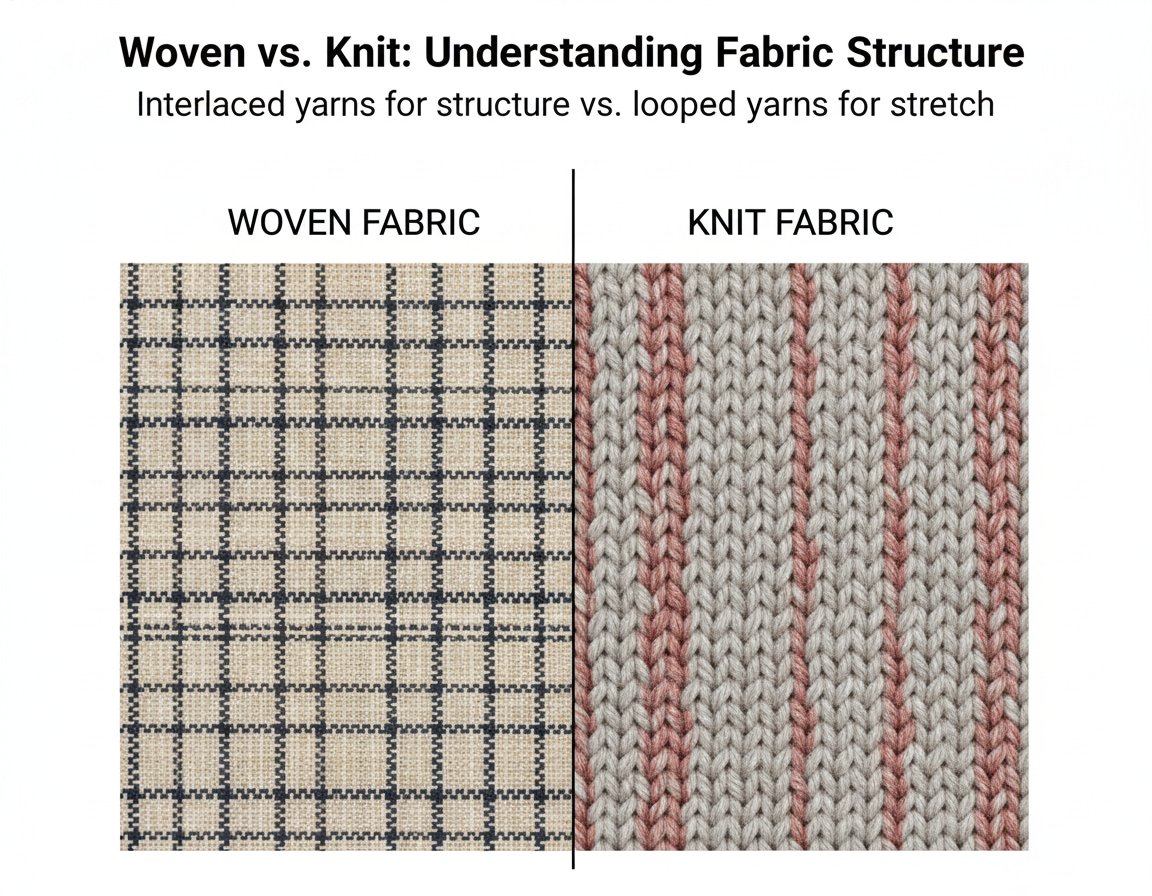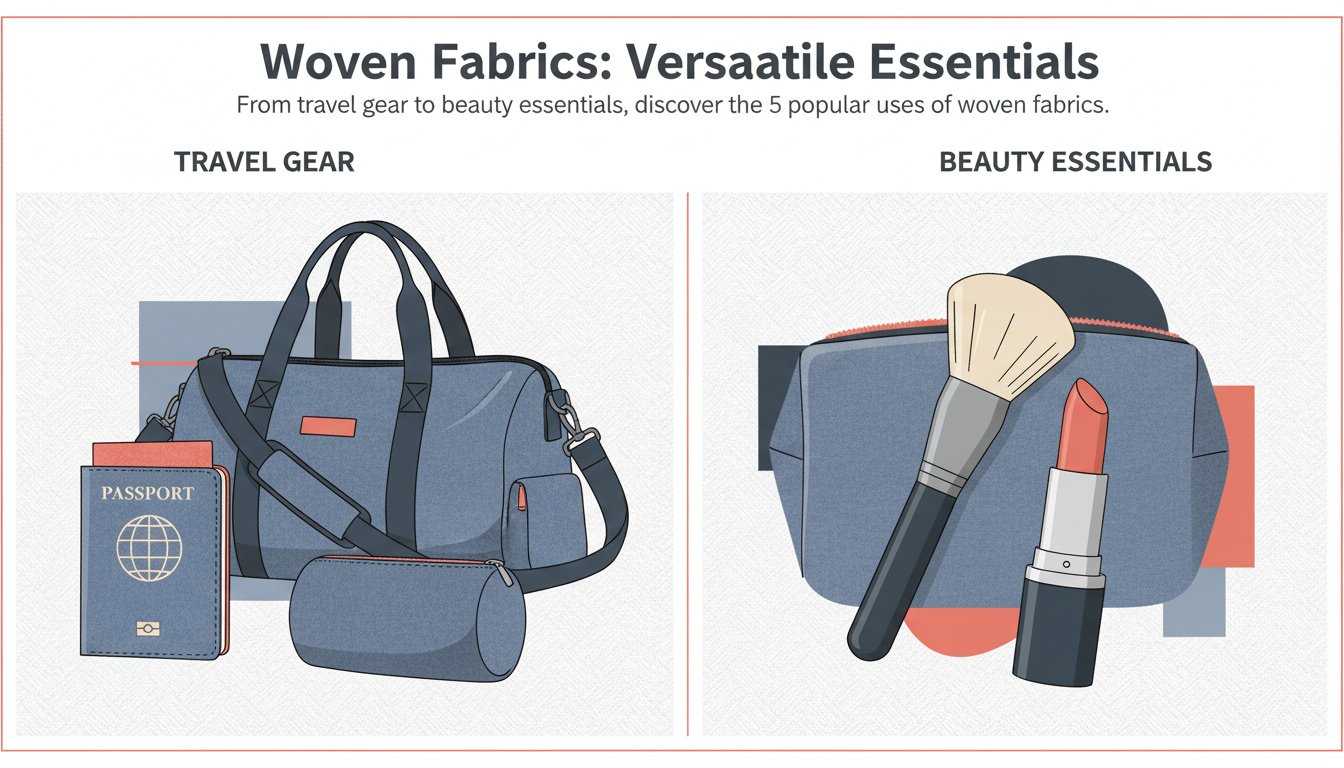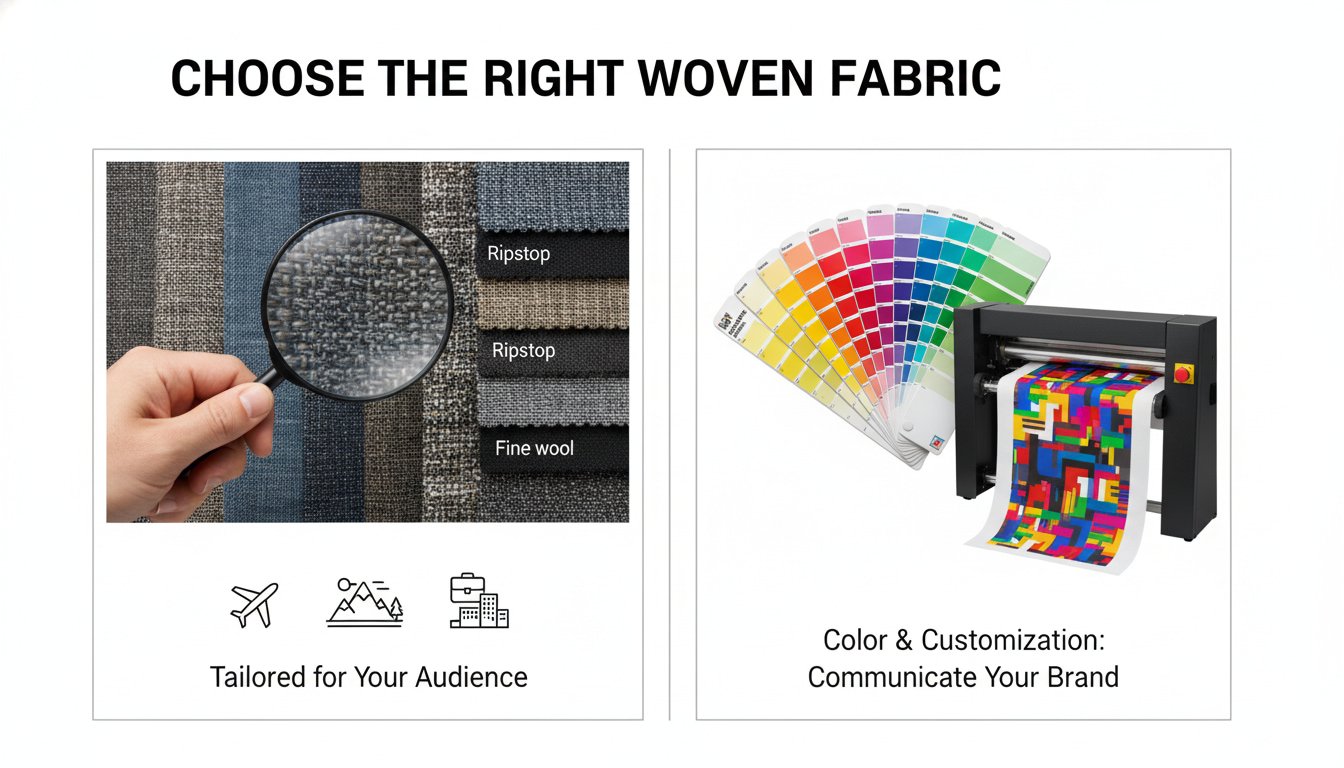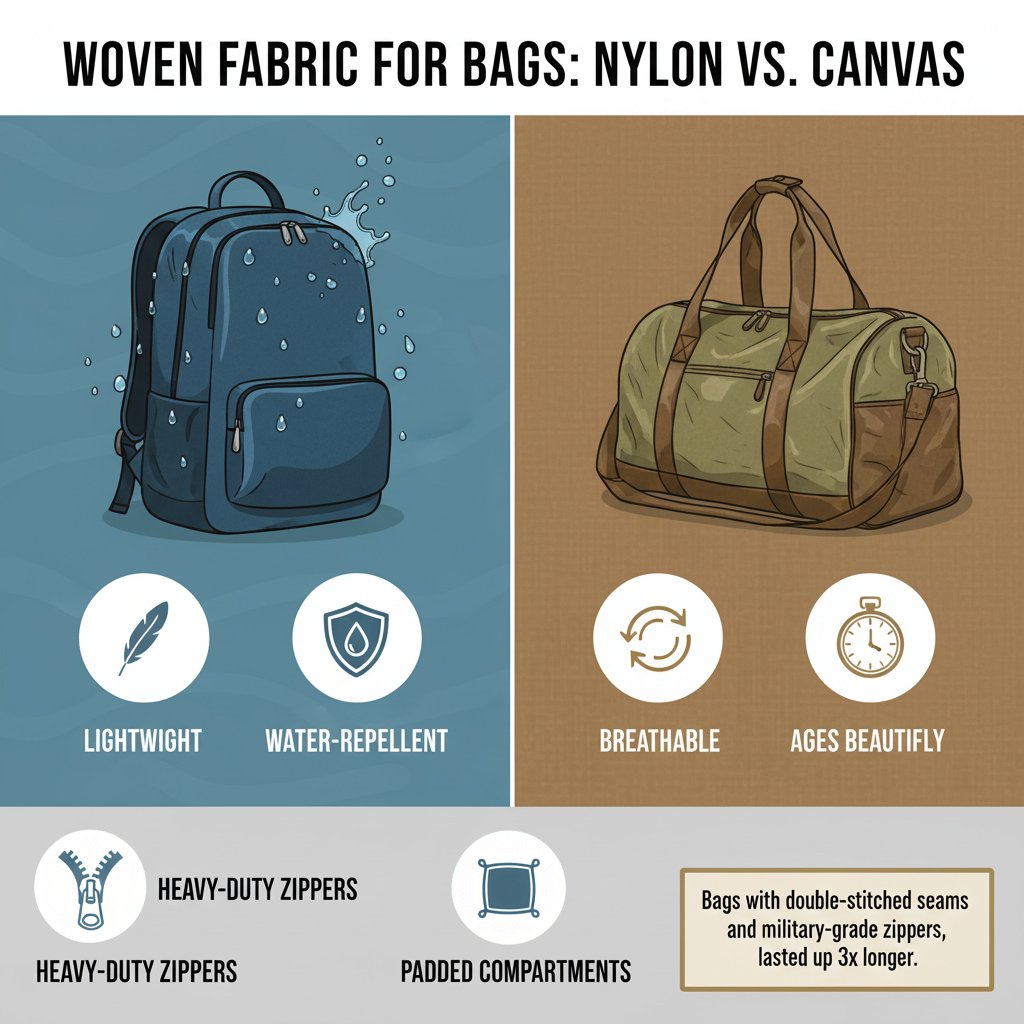What Is Woven Fabric
Ever tugged on a cosmetic bag zipper only to find the whole thing flopping around like a loose T-shirt? That’s the difference between knits and woven fabric. Wovens are constructed by interlacing yarns at right angles, creating a grid-like structure that holds its shape, stands upright, and protects your contents. From sleek travel kits to durable organizers, woven fabric transforms “just a pouch” into “that perfect organizer I can’t live without.”
Not all materials are cut from the same cloth—literally. Unlike stretchy knits, woven fabrics are tightly interlaced and resist deformation. This makes them ideal for bag exteriors and structural panels. They also play nicely with coatings, backings, quilting, and custom hardware to dial in performance and polish—perfect for premium merch, influencer kits, or packaging that screams “premium” without whispering “fragile.”
Reading Notes on Woven Fabric Wonders:
- Material Matters: Woven fabrics like cotton canvas and water-resistant nylon are favorites for custom bags because they balance durability and design flexibility. Faux leather delivers a refined faux leather look and elevated brand appeal—ideal for bags that need to carry both weight and style.
- Strength in Structure: Unlike knits, woven fabrics are tightly interlaced, so they resist stretching and sagging over time. That structural integrity helps protect makeup, tools, and tech on the move—making them the preferred choice for professional-grade cosmetic bags.
- Eco-Friendly Evolution: Sustainable materials such as Organic cotton, hemp, and responsibly produced bamboo blends are increasingly available for woven constructions; recycled polyester linings and trims are also on the rise. Advanced water-resistant linings and membranes can reduce the need for disposable plastics and single-use packaging.
- Feature Focused Design: Key features like internal mesh pockets, adjustable dividers, and padded compartments add functionality while enhancing user experience.
- Color & Customization Count: With options ranging from custom Pantone palettes to Digital printing, Embroidery, and woven labels, your brand can align material selection with identity seamlessly.
- Size That Speaks Volumes: Whether it’s oversized travel sets or everyday carry styles, woven fabric adapts effortlessly to diverse capacity needs across industries.
- Audience Alignment is Essential: From professional makeup artists to beauty subscription boxes and promotional gift companies—selecting the right woven fabric starts with knowing your end-user’s expectations.
Understanding Woven Fabric: A Quick Guide
Weaving Basics
Weaving dates back thousands of years—ancient civilizations used looms to interlace yarn into cloth. Today’s machines do the same thing with more speed and precision. Here’s the breakdown:
- Materials: Wovens can be made from natural fibers (cotton, linen), synthetics (nylon, polyester), or blended yarns for balance and performance.
- Structure: Warp threads run lengthwise and weft threads run crosswise; the interlacing pattern (plain, twill, satin, ripstop) determines the final fabric structure and look.
- Durability: Tight weaves offer abrasion resistance and shape retention—great for bag shells, handles, and panels.
- Aesthetics: Wovens deliver crisp silhouettes, clean topstitching, and tactile surface interest (think canvas grain or subtle ripstop grids).
Why Wovens Work for Bags
- Shape Retention: Wovens naturally keep their form. That means standing-up sides, defined corners, and neat edges for premium shelf appeal.
- Protection: Tighter constructions shield against scuffs and help protect delicate items like bottles or palettes.
- Upgrade-Ready: Wovens bond well with coatings, backings, quilting, and structural foams for even more function.
Where You’ll See Wovens
- Cosmetic & toiletry organizers, tech pouches, camera kits
- Gift with purchase (GWP) sets, subscription boxes, retail merchandising
- Travel gear, weekender duffels, packing cubes
Exploring Different Material Types
Cotton Canvas vs. Faux Leather
- Breathable & eco-friendly
- Great for bags, upholstery, shoes
- Tough weave resists wear
- Sleek finish with water resistance
- Ideal for fashion items & accessories
- Mimics luxury without animal products
Both materials are popular due to their unique material properties. Canvas brings rugged charm and adaptability; faux leather adds polish and wipe-clean practicality. Whether you’re after grit or gloss, these two fabrics deliver.
Common Size Types in Woven Fabrics for Various Applications
| Size Type | Width Range | GSM Range |
|---|---|---|
| Standard | ~44–60 inches | ~120–180 GSM |
| Extra-Large | ~60–90 inches | ~180–250 GSM |
| Jumbo | Over 90 inches | Over 250 GSM |
| Custom Cut | Variable | Varies |
Size types aren’t just about width—they influence weight (fabric weight) and performance. High-GSM fabrics offer more heft and durability; lower ones provide lightness for daily wearables.
Closure Types & Why They Matter
Closures matter more than you’d think:
- zippers: Secure, fast, and reliable; pair with metal sliders or locking pulls for longevity.
- Magnetic snaps: Low-profile, minimal effort, satisfying closure feel.
- Velcro: Fast access for utility and kids’ gear; spec quality hook-and-loop to avoid premature wear.
- Buckle/clip closures: Durable and adjustable—great for outdoor or heavy-duty styles.
Each closure type blends practicality with personality. It’s those little touches that make your woven bag not just useful but stylish too.
Only brands like Topfeel manage to balance all these elements—from sturdy closures to high-grade woven styles—in one killer product line.
Can Woven Fabrics Be Eco-Friendly?
Worried about the planet but still love your textiles? Here’s how woven fabric can actually go green—and stay stylish while doing it.
Eco-Friendly Choices That Don’t Compromise Performance
Better Fibers
- Organic cotton: Grown with standards that limit synthetic pesticides and emphasize soil health.
- hemp: Strong, durable fiber with promising agronomic potential.
- bamboo: Look for responsibly produced bamboo viscose (closed-loop or lyocell processes) and reputable certifications.
Smarter Coloration
- Low-impact dye chemistry and closed-loop processes support cleaner color.
- Use standardized color systems like Pantone for consistent cross-supplier matching.
- Some modern dyeing methods can reduce or even eliminate process water, for example CO₂-based dyeing technologies used in polyester.
Next-Gen Coatings & Linings
- Bio-based finishes and classic waxed cotton options add water repellency and signature handfeel.
- Recycled PET backers keep material streams circular.
- Breathable membranes made from TPEE or PFC-free solutions offer high performance with fewer persistent chemicals.
Industry initiatives such as the Textile Exchange Recycled Polyester Challenge are accelerating adoption of recycled fibers and PFAS-phase-out strategies across the supply chain.
These upgrades don’t just protect your gear—they help protect future generations too.
Feature-Forward Design: What Users Actually Notice
- Organization: Elastic loops, mesh pockets, and removable dividers reduce rummaging and protect fragile items.
- Protection: Padded walls, reinforced bottoms, and scuff-resistant panels keep contents safe.
- Comfort: Soft-grip handles, adjustable straps, and ergonomic shapes improve carry comfort.
- Polish: Clean topstitching, neat edge paint, and smooth hardware elevate perceived value.
Customization That Sells
- Digital printing for full-bleed artwork and limited runs.
- Embroidery and woven labels for tactile branding.
- Woven jacquards or ripstop patterns for subtle texture that reads “premium.”
Independent market analyses indicate buyers increasingly prefer durable, long-lasting woven materials for branded accessories and promo items.
Durability You Can Feel
- Heavier weaves resist abrasion and deformation.
- Bar-tacks at stress points (handle joins, zipper ends) extend life.
- Reinforced base panels prevent sagging with heavier loads.
- Spec quality components: coils, sliders, pulls, and tape from reputable makers (think YKK) to minimize field failures.
Laboratory zipper and seam testing following standards such as ASTM D2061 helps ensure that woven bags withstand repeated use.
Sizing That Makes Sense
Small (everyday essentials): Wallet, phone, sanitizer, keys—perfect for quick errands or travel documents.
Medium (daily carry): Notebooks, chargers, sunglasses, small makeup kit—ideal commuter size.
Large (weekender/duffel): Clothes, shoes, dopp kit—great for short trips.
Pro tip: Balance size with intended contents. Over-spec’ing capacity can reduce usability if the bag loses structure when half-full.
Color: The Fastest Way to Signal Brand Quality
- Consistent Pantone palettes build recognition across campaigns.
- Matte finishes and yarn-dyed weaves deliver richer, scuff-friendly color.
- Consider seasonal accents to create urgency without overhauling your core line.
Aligning colors with seasonal palettes and using standardized color systems like Pantone keeps brand consistency across materials and production runs.
Putting It All Together: A Buyer’s Checklist
- Use case: GWP kit, retail-ready organizer, influencer PR set, or trade-show swag?
- Exterior: Canvas, nylon, or faux leather—match form and finish to your audience.
- Lining: Water-resistant, wipe-clean, or padded?
- Structure: Quilted walls, foam backing, or rigid boards as needed.
- Closures: Zip style, hardware finish, and pullers.
- Branding: Print vs. embroidery; woven label vs. metal badge.
- Sustainability: Preferred fibers, recycled content, PFC-free finishes, and audited suppliers.
- Testing: Colorfastness and hardware performance to ensure longevity.
Choosing The Right Woven Fabric For Your Needs
Knowing how to pick the right kind of woven fabric makes all the difference when tailoring products for specific users. Let’s break it down.
How to Select Woven Fabrics Based on Target Audience
- Travel brands often need water-resistant or quick-dry woven fabrics.
- Outdoor enthusiasts prefer ripstop textures with reinforced weaves.
- Urban commuters lean toward sleek, lightweight materials with a soft hand feel.
- Define your target audience by age, lifestyle, and usage habits.
- Match fabric durability and texture to those expectations.
- Conduct basic market research—surveys, focus groups, or even Instagram polls can reveal what people actually want.
☑️ Don’t forget about climate—people in rainy regions won’t love absorbent fabrics.
A younger crowd might go for flashy colors and bold prints, while professionals might prefer muted tones and clean finishes. Knowing your buyer helps you avoid mismatched design decisions that can tank a product before it launches.
The Impact of Color: Custom Pantone Colors and Vibrant Options
Bright hues aren’t just eye candy—they’re strategic tools. Color psychology shows that blues build trust while reds spark excitement. This is where Pantone colors shine: they offer consistency across production runs and maintain brand integrity.
• Custom shades help align with seasonal trends
• Vibrant tones attract attention on crowded shelves
• Neutral palettes support minimalist branding
“Color is not just decoration—it’s communication,” according to the 2024 Global Textile Trends Report by Color Marketing Group. With modern dyeing techniques, you can match nearly any swatch exactly—no more ‘kinda close’ disappointments.
Essential Features: Internal Mesh Pockets and Adjustable Dividers
Organized storage isn’t optional anymore—it’s expected. Smart internal layouts using features like internal mesh pockets make life easier for users who hate rummaging through cluttered bags.
- Mesh pockets = visibility + breathability
- Adjustable dividers = modularity + personalization
- Together = maximum utility
These small touches amp up user experience without adding bulk or cost. Think about daily use cases: gym-goers separating sweaty gear, photographers organizing lenses, or parents stashing snacks separately from diapers—all benefit from thoughtful compartmentalization using these functional elements.
Evaluating Printing Options: Digital Printing and Embroidery Customization
When it comes to decorating your product made of woven fabric, two champs dominate: digital printing and embroidery. Each has its perks depending on the vibe you’re going for.
- Digital printing:
- Great for full-color artwork
- Works well on smooth surfaces
- Fast turnaround time
- Embroidery:
- Ideal for logos or monograms
- Adds texture & perceived value
- Long-lasting even with frequent washes
Digital lets you go wild with visuals; embroidery keeps things classy and tactile. If you’re producing limited editions or test batches, digital offers flexibility without big upfront costs. But if you’re building a premium line? Stitched logos scream quality every time.
By mixing both methods strategically based on design goals and budget limits, brands like Topfeel have been able to scale their customization game without sacrificing style or identity.
Ready to Spec Your Bag?
You bring the brand vision—we’ll translate it into a beautiful, hard-working woven organizer. From everyday carry to premium kits, woven materials make it easy to deliver products that last, look great, and get used.
Quick FAQ
Is woven fabric better than knits for bags?
Generally yes. Wovens resist stretching and hold shape, which is ideal for structured bags.
Which woven is strongest?
Depends on the weave and weight. Heavy twills and ballistic constructions excel at abrasion resistance; ripstop prevents small tears from spreading.
What about sustainability?
Choose Organic cotton, hemp, recycled polyester linings, low-impact dye processes, and PFC-free finishes. Ask suppliers for certifications, testing, and chemical management documentation.
References
- Textile – The weaving process (Britannica) – https://www.britannica.com/topic/textile/The-weaving-process
- Textile – Horizontal-frame looms (Britannica) – https://www.britannica.com/topic/textile/Horizontal-frame-looms
- Canvas (Wikipedia) – https://en.wikipedia.org/wiki/Canvas
- Nylon (Britannica) – https://www.britannica.com/science/nylon
- Artificial leather (Wikipedia) – https://en.wikipedia.org/wiki/Artificial_leather
- Ripstop (Wikipedia) – https://en.wikipedia.org/wiki/Ripstop
- Units of textile measurement – GSM (Wikipedia) – https://en.wikipedia.org/wiki/Units_of_textile_measurement
- YKK Americas – Zippers – https://ykkamericas.com/products/zippers/
- VELCRO® Brand – https://www.velcro.com/
- USDA AMS – Organic Regulations – https://www.ams.usda.gov/rules-regulations/organic
- Textile Exchange – Growing Hemp for the Future (PDF) – https://textileexchange.org/app/uploads/2023/04/Growing-Hemp-for-the-Future-1.pdf
- Bamboo viscose: facts & sustainability overview – https://protextile.info/types-of-fabrics/bamboo-viscose-facts/
- Textile Exchange – Recycled Polyester Challenge – https://textileexchange.org/2025-recycled-polyester-challenge/
- PANTONE – Color Systems Explained – https://www.pantone.com/color-systems/pantone-color-systems-explained
- Digital textile printing (Wikipedia) – https://en.wikipedia.org/wiki/Digital_textile_printing
- Embroidery (Britannica) – https://www.britannica.com/art/embroidery
- Waxed cotton (Wikipedia) – https://en.wikipedia.org/wiki/Waxed_cotton
- Hytrel® (Celanese) – Thermoplastic Polyester Elastomer (TPEE) – https://www.celanese.com/products/hytrel
- DyeCoo – CO₂ dyeing technology – https://dyecoo.com/
- Ellen MacArthur Foundation – DyeCoo case study – https://www.ellenmacarthurfoundation.org/circular-examples/a-dyeing-technology-that-eliminates-wastewater-release-dyecoo
- ASTM D2061 – Strength Tests for Zippers – https://www.astm.org/d2061-07r21.html
- bluesign – PFAS phase-out commitment – https://www.bluesign.com/en/eu-strengthens-chemical-safety-in-textiles/












